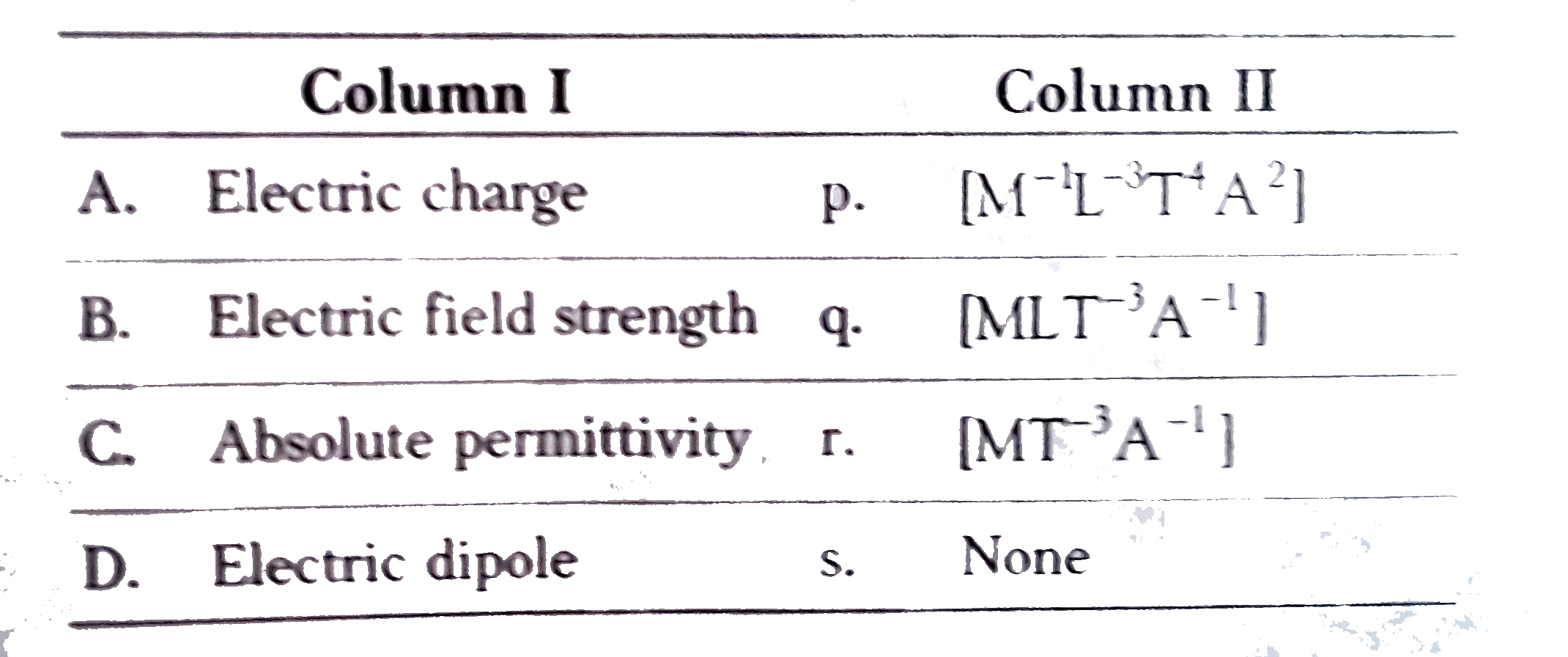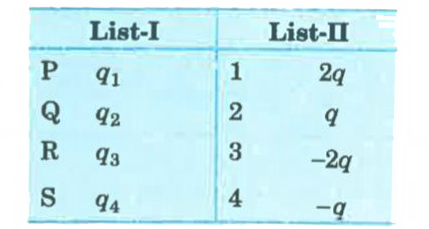Three concentric metallic spherical shells of radii R, 2R, 3R are given charges Q1Q2Q3, respectively. It is found that the surface charge densities on the outer surface of the shells are equal. Then, the ratio of the charges given to the shells Q1:Q2:Q3 is
1:2:3
1:3:5
1:4:9
1:8:18
The correct Answer is:B
To solve the problem, we need to find the ratio of the charges Q1:Q2:Q3 on three concentric metallic spherical shells with radii R,2R, and 3R respectively, given that the surface charge densities on the outer surfaces of the shells are equal.
1. Understanding Surface Charge Density:
The surface charge density σ on a spherical shell is defined as:
σ=QA
where Q is the charge on the shell and A is the surface area of the shell.
2. Calculating Surface Areas:
The surface area A of a sphere is given by 4πr2. Therefore, the surface areas for the three shells are:
- For the first shell (radius R):
A1=4πR2
- For the second shell (radius 2R):
A2=4π(2R)2=16πR2
- For the third shell (radius 3R):
A3=4π(3R)2=36πR2
3. Setting Up the Equation for Equal Surface Charge Densities:
Since the surface charge densities are equal, we can write:
σ1=σ2=σ3
This gives us the equations:
Q14πR2=Q216πR2=Q336πR2
4. Simplifying the Equations:
We can cancel 4πR2 from each term:
Q1=k⋅4(1)
Q2=k⋅16(2)
Q3=k⋅36(3)
where k is a constant.
5. Finding the Ratios:
Now we can express the charges in terms of k:
- From (1): Q1=4k
- From (2): Q2=16k
- From (3): Q3=36k
Therefore, the ratio of the charges is:
Q1:Q2:Q3=4k:16k:36k
Simplifying this gives:
Q1:Q2:Q3=4:16:36
Dividing each term by 4:
Q1:Q2:Q3=1:4:9
Final Answer:
The ratio of the charges given to the shells is:
Q1:Q2:Q3=1:4:9
The surface charge density σ on a spherical shell is defined as:
σ=QA
where Q is the charge on the shell and A is the surface area of the shell.
The surface area A of a sphere is given by 4πr2. Therefore, the surface areas for the three shells are:
- For the first shell (radius R):
A1=4πR2
- For the second shell (radius 2R):
A2=4π(2R)2=16πR2
- For the third shell (radius 3R):
A3=4π(3R)2=36πR2
Since the surface charge densities are equal, we can write:
σ1=σ2=σ3
This gives us the equations:
Q14πR2=Q216πR2=Q336πR2
We can cancel 4πR2 from each term:
Q1=k⋅4(1)
Q2=k⋅16(2)
Q3=k⋅36(3)
where k is a constant.
Now we can express the charges in terms of k:
- From (1): Q1=4k
- From (2): Q2=16k
- From (3): Q3=36k
Q1:Q2:Q3=4k:16k:36k
Simplifying this gives:
Q1:Q2:Q3=4:16:36
Dividing each term by 4:
Q1:Q2:Q3=1:4:9
The ratio of the charges given to the shells is:
Q1:Q2:Q3=1:4:9
Topper's Solved these Questions
- ELECTROSTATICSBOOK - DC PANDEY ENGLISHCHAPTER - ELECTROSTATICSEXERCISE - Assertion and Reason
15 Videos
- ELECTROSTATICSBOOK - DC PANDEY ENGLISHCHAPTER - ELECTROSTATICSEXERCISE - Match the columns
5 Videos
- ELECTROSTATICSBOOK - DC PANDEY ENGLISHCHAPTER - ELECTROSTATICSEXERCISE - Check point 1.5
20 Videos
- ELECTROSTATIC POTENTIAL AND CAPACITORSBOOK - DC PANDEY ENGLISHCHAPTER - ELECTROSTATIC POTENTIAL AND CAPACITORSEXERCISE - (C) Chapter exercises
50 Videos
- GRAVITATIONBOOK - DC PANDEY ENGLISHCHAPTER - GRAVITATIONEXERCISE - All Questions
135 Videos
Similar Questions
Assertion Mass of ion is slightly differed from its element.
Reason Ion is formed, when some electrons are removed or added, so mass changes.
View SolutionMatch the following two columns.

View SolutionThe law goverening electrostatics is coulomb's law.In priciple coulomb's law can be used to compute electric field due to any charge configuation .In pracitce however it is a formidable task to compute electric field due to uniform charge distributions .For such cases Gauss proposed a theorem which states that
∮¯¯¯E.¯¯¯¯ds=qε0
where ds is an element of area directed across the outward normal for the surface at every point .The integral is called electric flux.Any convenient surface that we choose to evalute the surface integral is called the Gaussian surface.
The SI unit of electric flux is
View SolutionA capacitor of 2μF is charged as shown in the figure. When the switch S is turned to position 2, the percentage of its stored energy dissipated is

View SolutionAn infinite number of particles each of mass m are placed on the positive X-axis of 1m,2m,4m,8m,... from the origin. Find the magnitude of the resultant gravitational force on mass m kept at the origin.
View SolutionTwo concentric spherical shells of radii R and 2R are given charges Q1andQ2 respectively.
The surfaces charge densities of the outer surfaces are equal. Determine the ratio Q1:Q2.
View SolutionA small sphere of radius r1 and charge q1 is enclosed by a spherical shell of radius r2 and charge q2. Show that if q1 is positive, charge will necessilly flow from the sphere to the shell (when the two are connected by a wire) no matter what the charge q2 on the shell is [Fig]
View SolutionThree concentric metallic spherical shells of radii R, 2R, 3R are given charges Q_(1) Q_(2) Q_(3) , respectively. It is found that the surface charge densities on the outer surface of the shells are equal. Then, the ratio of the charges given to the shells Q_(1) : Q_(2) : Q_(3) is
View Solutionr1 त्रिज्या तथा q1 आवेश वाला एक छोटा गोला r2 त्रिज्या और q2 आवेश के गोलीय खोल (कोश) से घिरा है । दर्शाइए यदि q1 धनात्मक है तो (जब दोनों को एक तार द्वारा जोड़ दिया जाता है) आवश्यक रूप से आवेश, गोले से खोल के तरफ ही प्रवहित होगा, चाहे खोल पर आवेश q2 कुछ भी हो ।
View Solutionधातु के बने R,2R तथा 3 R त्रिज्याये वाले तीन खोखले सेकेंडरी गोलों को क्रमशः Q1,Q2 तथा Q3 आवेश दिए जाते है तीनो गोले की बाहरी सतह पर आवेश के घनत्व बराबर पाए जाते है तब दिए गए आवेशों का अनुपात Q1:Q2:Q3 होगा
View Solutionr1 त्रिज्या तथा q1 आवेश वाला एक छोटा गोला, A,r2 त्रिज्या और q2 आवेश के गोलीय खोल (कोश) से घिरा है| दर्शाइए | यदि q1 धनात्मक है तो (जब दोनों को एक तार द्वारा जोड़ दिया जाता है) आवश्यक रूप से आवेश, गोले से खोल की तरफ ही प्रवाहित होगा, चाहे खोल पर आवेश q2 कुछ भी हो|
View Solutionदो सकेंद्रिय गोलीय खेलो को जिनकी त्रिज्याएँ R और 2R है, क्रमशः Q1 और Q2 आवेश दिए गए है। खोलो में पृष्ठ आवेश घनत्व समान है। Q1Q2 की गणना कीजिए।
View SolutionThree concentric metallic spherical shells of radii R, 2R, 3R are given charges Q1Q2Q3, respectively. It is found that the surface charge densities on the outer surface of the shells are equal. Then, the ratio of the charges given to the shells Q1:Q2:Q3 is
View SolutionThere are three concentric metallic spherical shells of radii R, 2R and 3q, respectively. The middle spherical shell is connected to earth. Let q1 be the charge appearing on the inner surface of the middle sphere and q2 be the charge on outer surface of the middle sphere. Similarly q3 is the charge appearing on inner surface of outermost sphere and q4 is the charge appearing on outer surface of outermost sphere.

View SolutionA small sphere of radius r1 and charge q1 is enclosed by a spherical shell of radium r2 and charge q2. Show that if q1 is positive , charge will neecessarily flow from the sphere to the shell ( when the two are connected by a wire ) no matter what the charge q2 on the shell is .
View Solution

